新概念第一册lesson9
- 格式:ppt
- 大小:5.52 MB
- 文档页数:71
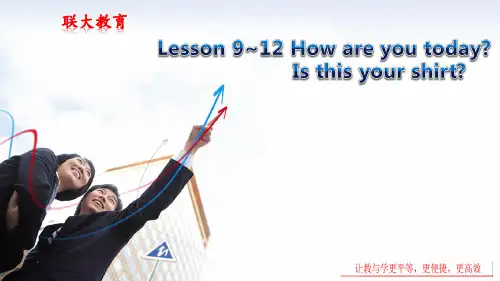
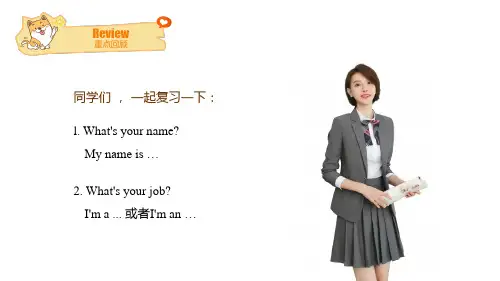
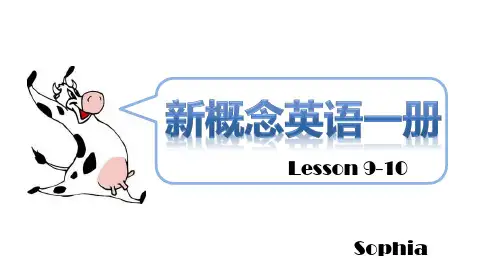
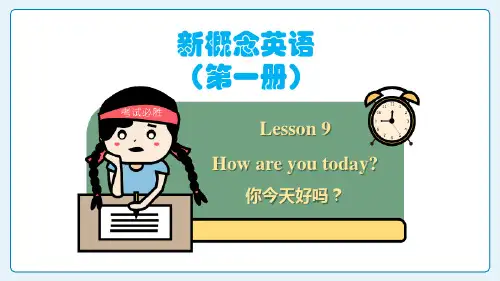
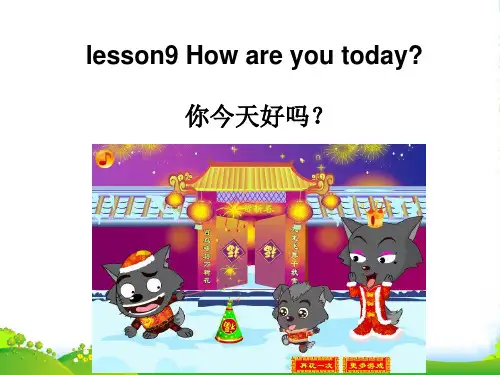
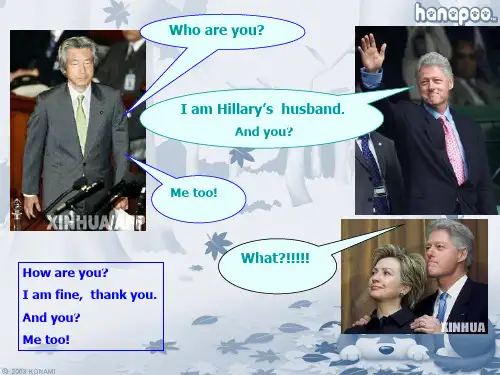
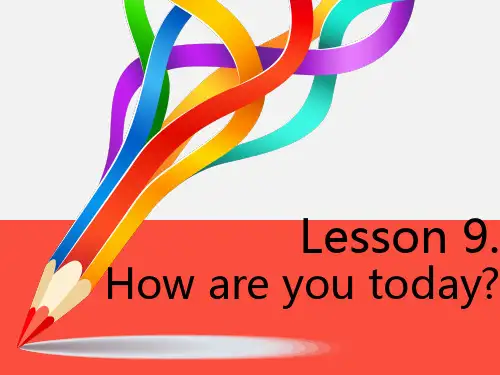
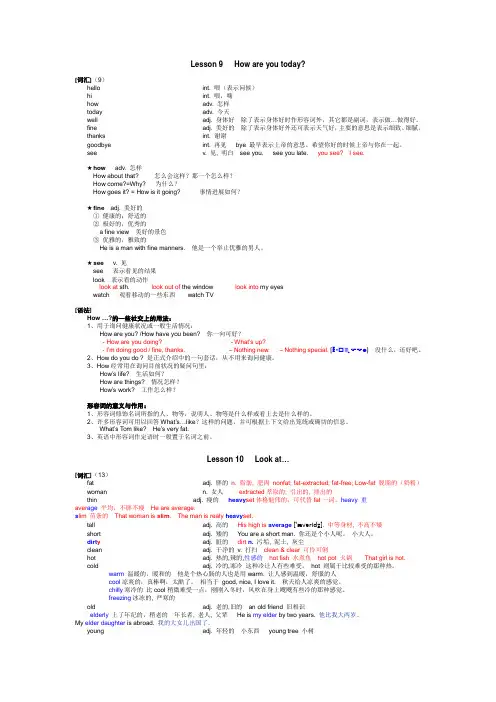
Lesson 9 How are you today?[词汇](9)hello int. 喂(表示问候)hi int. 喂,嗨how adv. 怎样today adv. 今天well adj. 身体好除了表示身体好时作形容词外,其它都是副词,表示做…做得好。
fine adj. 美好的除了表示身体好外还可表示天气好,主要的意思是表示细致、细腻。
thanks int. 谢谢goodbye int. 再见bye 最早表示上帝的意思。
希望你好的时候上帝与你在一起。
see v. 见, 明白see you. see you late. you see? I see.★how adv. 怎样How about that? 怎么会这样?那一个怎么样?How come?=Why? 为什么?How goes it? = How is it going? 事情进展如何?★fine adj. 美好的①健康的;舒适的②极好的,优秀的a fine view 美好的景色③优雅的,雅致的He is a man with fine manners. 他是一个举止优雅的男人。
★see v. 见see 表示看见的结果look 表示看的动作look at sth. look out of the window look into my eyeswatch 观看移动的一些东西watch TV[语法]How …?的一些社交上的用法:1、用于询问健康状况或一般生活情况:How are you? /How have you been? 你一向可好?- How are you doing? - What’s up?- I’m doing good / fine, thanks. – Nothing new. – Nothing special. [ ] 没什么,还好吧。
2、How do you do ? 是正式介绍中的一句套话,从不用来询问健康。

每日一句:An apple a day keeps the doctor away. 一日一苹果病痛远离我Lesson 9 How are you today? & Lesson 10 Look at…一.教学重点1.How are you? 句型的表达及回答2.记住形容词的句型:正反意词二.教学步骤1. 引入Good morning! 早上好~这是我们之前学习过见面打招呼可以说的第一句话,那我要是接着要开始和你聊天的话,我们可以接着怎么说呢?我们现在会说,诶,最近怎么样啊?而外国人会说How are you? 其实跟我们一样,他们也会打招呼说,你好么?而我们该怎么回答呢?听听课文就知道了。
在听课文之前,要记住我的问题哦,How is Emma?3. 课文精讲1.How are you today?你今天好吗?这是朋友或相识的人之间见面时问对方身体情况的寒暄话,一般回答语为:Fine, thank you. 很好,谢谢。
I'm fine/great, thank you. 很好,谢谢。
I'm very well, thank you. 很好,谢谢。
如果是很熟悉的朋友,大家也可以回答,Not bad。
当然,因为这属于寒暄语,所以我们就算心情很差,一般也不会直接的就说bad. 除非是极要好的朋友,你需要聊天和倾诉,也可以说not good, 朋友会追问why?,这样就产生出更多的对话。
如问及对方的先生或太太或家中其他亲属的情况,可以说How is Tony?或How's Emma?等。
相应的回答可为 He's fine,thanks 或 She's very well,thankyou等。
直接把主语换成He /She 即可。
2.And you?你好吗?是And how are you?的简略说法。
在回答对方问候健康的话之后反问时用。
3.数字21与22的英文写法21—twenty-one 22—twenty-two4. 语法要点1)How…?的一些社交上的用法how 是一个表示“如何”的疑问词,可以用来引导一些用于社交场合的套话:(1)用于询问健康状况或一般生活情况:How are you? 你好吗?How is Helen today? 海伦今天好吗?(2)How do you do?(你好吗?)是正式介绍中的一句套话,从不用来询问健康:回答也是How do you do?(3)how 经常用在询问目前状况的疑问句里,如: How's life? 生活如何?How are things? 情况怎样? How's work? 工作怎么样?2.形容词的意义与作用(1)形容词修饰名词所指的人、物等。

新概念lesson9798课堂重点一.单词语法点:1)leave : (left, left) v. 遗留n.假期,休假短语:leave for 动身去...2)describe:v. 描述派生词descriptive adj. 描写的,叙述的短语: describe...as...把...说成...;把...称为...3)label : n.标签vt. 贴标签于be labelled with把…称为;把…列为be labelled as4)handle:n.提手,把手v. 管理,处理,对付5)address:n. 地址,演说,致词v.在...上写姓名和地址,称呼6)pence : n. penny的复数形式7)belong:v. 属于短语:belong to属于...(不能用于进行时态和被动)二.物主代词物主代词是表示所有关系的一种代词,亦称所有格。
物主代词有两种形式:形容名词性物主代词起名词的作用,后面不可以再接名词。
在句子中可以作主语,宾语或表语。
三.动词let动词let与普通动词的用法不同,后接宾语+动词原形,做宾语补足语。
如:Let him e in .I'll let you know.let us一般简写为let's ,以let's 开头的句子常用做一种委婉的祈使句。
如:Let's begin our class.四. 课文语法点1.I left a suitcase on the train to London the other day.leaveleftleftthe train to +地点the other day不久前一天,一般过去时标志词2.It's a small blue case and it’s got a zip. There’s a label on the handle with my name and address on it.形容词的位置顺序:限定描绘大长高,形状年龄和新老,颜色国籍跟材料,作用类别往后靠。
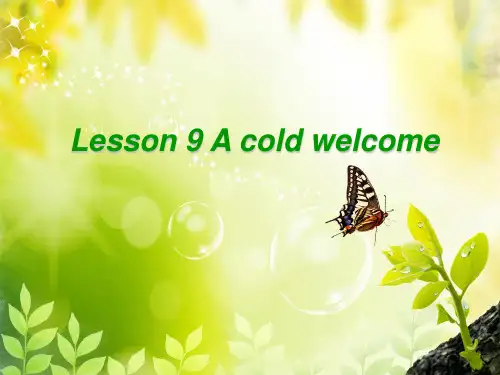
Lesson912课堂重点一、How引导的特殊疑问句How 提问身体状况;交通工具;如何;怎样;How are you ?I am fine / very well / great / not too badHow is Tony ?He is+fine / very well / great / not too badHow do you go to school?I go to school by bus.二、特殊疑问句提问谁的Whose提问谁的结构:Whose+名词+一般疑问句Whose shirt is that?/Whose books are those?Whose+一般疑问句Whose is that shirt?/Whose are those books?回答:It’s+名词所有格/名词性物主代词/形代+名词It’s Tim’s./It’s hers./It’s my shirt.They are+名词所有格/名词性物主代词/形代+名词They are Mary’s./They are mine./They are her books.三、形容词的用法1)形容词+名词a nice person\a beautiful girl2)Be+形容词I am good.It is interesting四、感谢用语thanks 谢谢thank youthank sb感谢某人Thanks a lot非常感谢Thank you very much五、名词所有格(表示所属关系)~的1)名词所有格’s’s表示所有关系归谁所有在谁后面加’s,译为“的”Mary’s玛丽的Your father’s你父亲的以s结尾的复数加’students’学生们的2)A’s and B’s A的和B的,分别所属,两个,谓语动词用复数A and B’s A和B的,共同所属,一个,谓语动词用单数3)“名词1+of+名词2”名词2的名词1A of B译为B的A4)双重所有格有两种形式:①of+名词所有格;Eg:He is a friend of my brother's.②of+名词性物主代词。
⽆忧考新概念频道为⼤家整理的新概念英语课⽂原⽂:Lesson 9 A cold welcome,供⼤家参考。
更多阅读请查看本站频道。
Lesson 9 A cold welcome冷遇First listen and then answer the question.听录⾳,然后回答以下问题。
What does 'a cold welcome' refer to?On Wednesday evening, we went to the Town Hall. It was the last day of the year and a large crowd of people had gathered under the Town Hall clock. It would strike twelve in twenty minutes' time. Fifteen minutes passed and then, at five to twelve, the clock stopped. The big minute hand did not move. We waited and waited, but nothing happened. Suddenly someone shouted. 'It's two minutes past twelve! The clock has stopped!' I looked at my watch. It was true. The big clock refused to welcome the New Year. At that moment, everybody began to laugh and sing.New words and expressions ⽣词和短语welcome n. 欢迎;v. 欢迎crowd n. ⼈群gather v. 聚集hand n. (表或机器的)指针shout v. 喊叫refuse v. 拒绝laugh v. 笑参考译⽂星期三的晚上,我们去了市政厅。
新概念英语第一册Lesson 1 Excuse me! 对不起!Excuse me!对不起!Yes? 什么事?Is this your handbag? 这是您的手提包吗?Pardon? 对不起,请再说一遍。
Is this your handbag? 这是您的手提包吗?Yes,it is. 是的,是我的。
Thank you very much. 非常感谢!New words and expressions 生词和短语excuse v.原谅handbag n. (女用)手提包me pron.我(宾格) pardon int.原谅,请再说一遍yes adv.是的it pron.它is be 动词现在时第三人称单数thank you 感谢你(们) this pron.这very much 非常地your possessive adjective 你的,你们的Notes on the text 课文注释1.Excuse me.这个短语常用于与陌生人搭话,打断别人的说话或从别人身边挤过。
在课文中,男士为了吸引女士的注意力而用了这个表示客套的短语。
2.Pardon?全句为I beg your pardon. 意思是请求对方把刚才讲过的话重复一遍。
Lesson 3 Sorry, sir. 对不起,先生。
My coat and my umbrella please. 请把我的大衣和伞拿给我。
Here is my ticket. 这是我(寄存东西)的牌子。
Thank you, sir. 谢谢,先生。
Number five. 是5号。
Here's your umbrella and your coat. 这是您的伞和大衣。
This is not my umbrella. 这不是我的伞。
Sorry, Sir. 对不起,先生。
Is this your umbrella? 这把伞是您的吗?No, it isn't. 不,不是!Is this it? 这把是吗?Yes, it is. 是,是这把。